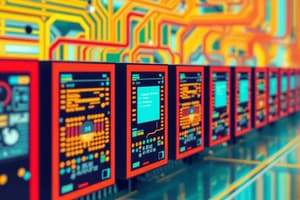Podcast
Questions and Answers
What was the main feature of the Integrated Circuit?
What was the main feature of the Integrated Circuit?
- It was a small chip of silicon
- It consisted of thousands of circuits on a small chip (correct)
- It was a timesharing operating system
- It was a microprocessor
What was the benefit of the Integrated Circuit in terms of power consumption?
What was the benefit of the Integrated Circuit in terms of power consumption?
- Power consumption was higher
- Power consumption was the same
- Power consumption was not a concern
- Power consumption was lower (correct)
What was the first high-level language to appear in the third generation?
What was the first high-level language to appear in the third generation?
- Python
- Basic (correct)
- Java
- C++
What was the first timesharing operating system?
What was the first timesharing operating system?
What was introduced in the third generation of computers?
What was introduced in the third generation of computers?
What was the characteristic of the third generation computers?
What was the characteristic of the third generation computers?
What was the first chip to house all the components of a computer processor?
What was the first chip to house all the components of a computer processor?
What was the characteristic of the Microprocessor?
What was the characteristic of the Microprocessor?
What generation of computers started in 1972 and ended in 1984?
What generation of computers started in 1972 and ended in 1984?
What was the main feature of the fourth generation of computers?
What was the main feature of the fourth generation of computers?
Flashcards are hidden until you start studying
Study Notes
Concept of ICTs
- Information Technology (IT) was first used in the early 1980s to indicate the convergence of computer technology and communication technologies.
- In the 1990s, the term Information and Communication Technologies (ICTs) was more widely used to replace IT, emphasizing the communication aspect.
Definition of ICTs
- ICTs is a field of work and study that includes technologies such as desktop and laptop computers, software, peripherals, and connections to the Internet for information processing and communications functions (Statistics Canada, 2008).
- According to UNESCO, ICTs is the combination of informatics technology with other related technologies, specifically communication technology (UNESCO, 2002).
Uses of ICTs in Various Sectors
- ICTs can be used to facilitate public and private sector activities in areas such as:
- Public Administration (e-Government)
- Transport sector (improving road, air, and rail transportation)
- Health Sector (supporting efficient exchange of information between health professionals and clients, telemedicine)
- Special Needs (for the Physically Challenged, providing access to communication, education, and opportunities)
- Education Sector (facilitating learning, exchange of educational materials, and online learning systems)
Effects of ICT Developments on the User Community
- Increases level of technology literacy
- Increases demand for better and faster access to information
- Aggravates discrepancies between the information rich and information poor
Impact of ICTs on Librarians and Library Education
- Need for ICT knowledge, skills, and tools
- Library schools must integrate ICTs into their curricula and short courses to produce graduates who can cope with the changing work environment
- Need for continuous learning in the context of rapidly changing ICT
Perceived Roles of Librarians/Information Managers
- Creators: developers and producers of information products and services
- Collectors: librarians, archivists, and records managers
- Communicators: information workers, extension workers, subject specialists
- Consolidators: reference librarians, information brokers, analysts
Trends in the Development of Libraries
- Networked libraries
- Libraries with a core collection that is multimedia
- Libraries with access to global information
- Libraries becoming digital and virtual
Mainframe Computer
- A large computer with enormous input, processing, output, and storage capacities
- Hundreds of terminals can be connected, allowing hundreds of users to work simultaneously
- Also known as "Father computer" or Host computer, Central data base server
Mini Computer
- A computer of medium power compared to Mainframes, but more powerful than micro computers
- Also known as mid-range computer or Child computer
- Application: Departmental systems, Network Servers, work group system
Micro Computer
- A small computer that contains a microprocessor as its central processor
- The central processing unit is embedded in a single chip
- Available for only one user at any time
- Also known as Grandchild Computer
- Examples: personal computers, Laptops, desktops
Time-Sharing (Processing Technique)
- A technique that allows multiple users to access the computer simultaneously
Generations of Computers
Third Generation (1964-1971)
- Integrated Circuit (electronic circuit on a small silicon chip)
- Reliability, compactness, and low cost
- High-level languages appeared (Basic)
- Operating systems were first used (MULTICS)
- Networking was introduced
- Introduction of minicomputers
Fourth Generation (1972-1984)
- Microprocessor (thousands of integrated circuits on a single silicon chip)
- The Intel 4004 chip was the first chip to house all the components of the computer processor (1971)
Studying That Suits You
Use AI to generate personalized quizzes and flashcards to suit your learning preferences.




